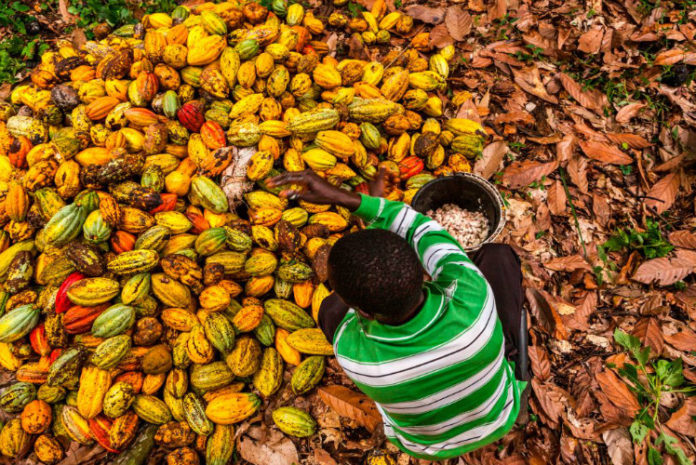As West Africa’s cocoa production withers due to bad weather, ageing trees and crop disease, enterprising farmers in an arid swath of Brazilian grasslands see an opportunity.
Growers across the western part of Bahia state — a hot, dry region known for its influential farming families who’ve built fortunes exporting cotton and soy — are now cultivating cocoa for the first time. The trees are still young with most at least a year away from producing fruit, but the potential payday is big. That’s enticing independent growers and corporate behemoths alike to get in on the action.
Agribusiness giant Cargill Inc. is partnering with a major farming group, Schmidt Agricola, to plant 400 hectares (about 990 acres) of cocoa more than an hour outside the Bahian city of Barreiras. Swiss chocolatier Barry Callebaut AG and a high-tech partner plan to co-develop about 5,000 hectares of cocoa plantations in the state. Farming families who already grow tropical fruits or commodity crops are this season adding rows of cocoa trees, too, in hopes of capturing a corner of an important global market that has eluded this part of Brazil for decades.
If production in the new region takes off, Brazil could nearly double its output to about 400,000 metric tons by 2030, estimates the country’s cocoa commission. That would bring the nation within striking distance of the No. 3 global spot, today occupied by Ecuador. And some say that forecast is too conservative. Moisés Schmidt, one of the brothers behind Schmidt Agricola, wagers production could reach 1.8 million tons a year in the next 10 years if growers continue to plant in new areas like the land he’s now cultivating, in addition to the more traditional cocoa regions in the country.
“Brazil is already the world’s largest supplier” of a large swath of commodities, from soybeans to orange juice, Schmidt said as a group of more than 1,000 landowners, academics and local authorities toured his land last month to see the seedlings themselves. “Where are we going to stand on cocoa?”
Brazil was once among the world’s top producers of the key chocolate-making ingredient, before many of the country’s cocoa trees fell ill due to an outbreak of witches’ broom starting in the late 1980s. Ivory Coast and Ghana today account for more than half of global output.
That concentration in just two countries makes the world’s supply more vulnerable to risks like poor weather and crop diseases, which are only intensifying as weather swings become more extreme. A recent shortfall in cocoa production in West Africa has driven global prices to more than double this year, pushing up consumer prices for chocolate bars and even forcing some chocolate makers to close.
The first farmers to plant cocoa in western Bahia started before the latest run-up in prices; now, neighbouring farms are also seeing the appeal. Growers in Bahia are generally better financed and larger than their West African counterparts, meaning they can achieve economies of scale. Brazilian farmers can also sell at market prices without interference from the government like in Ivory Coast and Ghana. And since the beans aren’t perishable, sellers can wait for the right time to do a deal.
With year-round sun, widespread irrigation and access to fertilizers, the cocoa harvest here can be accelerated, with some trees bearing fruit in three years instead of the more traditional five. Although one farmer described the climate as somewhere “between hot and hell,” established irrigation systems in the region mean farmers can keep their crops hydrated on even the warmest days.
“Cocoa is like a bug that’s catching on, and everyone who gets into it stays in it,” said Tal Bar-Dor, chief operations officer for a farm in the Brazilian city of Barra. Bar-Dor, who worked as a civil engineer in Israel and Nigeria before getting into farming, last year added cocoa trees to the coconut farm he manages. He’s planning to grow the fields to about 1,000 hectares in the next four years from just 45 hectares today.
Growers in other corners of Latin America are also eyeing growth. In Colombia, the nation’s largest food processor Grupo Nutresa is investing in a new nursery that’s targeting 10 million cocoa trees in the next five years. In Ecuador, already a major producer, farmers are expanding acreage and adding technology to boost output more than 50% in four years to 700,000 tons, according to Ivan Ontaneda, president of the country’s cocoa exporters association, Anecacao.
“Higher prices are definitely motivating farmers to invest in their fields,” he said. “West Africa’s current situation is an opportunity for Latin America.”
Back in western Bahia, farmer Claudia Sá choked up at the sight of Schmidt’s young orchards. Decades ago, she saw many of her family’s cocoa trees in the south of Bahia fall to witches’ broom; she recalls seeing her father search frantically for the few that were left untouched. While the disease was not eradicated, many farms learned how to deal with it, as scientists later found seedlings that were more resistant to the fungus.
“We came very close to not being here, to taking the country off the cocoa map,” she said during a visit to the new cocoa region about 600 miles away from her own farms. Now, “there are no more limits.”








